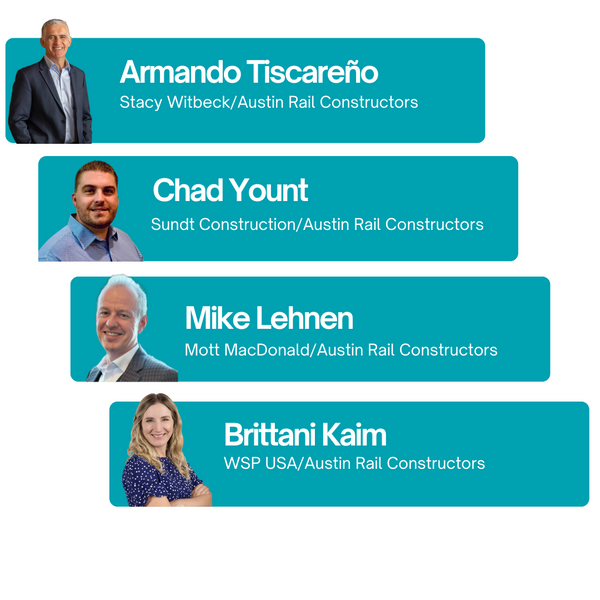Collaborative Delivery Models: Building Mobility Solutions That Start Before Construction Ends
Transit projects in dense urban environments come with a built-in tension: how do you build something that moves people—without bringing everything to a standstill in the process? Traditional delivery models often fall short, because they typically follow a linear, siloed process that delays critical coordination until late in the project lifecycle. This approach can lead to misaligned priorities, reactive risk management, and limited flexibility to adapt to evolving project scopes or community needs.
In contrast, collaborative approaches like Progressive Design-Build (PDB) and CM/GC are changing the game. By bringing contractors, designers, transit agencies, and communities to the table early—aligning priorities, identifying risks, and making smarter, faster decisions before construction even begins.
One example of this is Stacy Witbeck’s work as CM/GC on two consecutive five-year, task-order-based contracts to rehabilitate light rail stations along TriMet’s MAX Blue Line in Portland, Oregon. Stretching across 15 miles through dense public and transit right-of-way, the project involved targeted upgrades to station amenities, utilities, access points, and platform surfaces—all while keeping the line operational and maintaining safe access for pedestrians, cyclists, and vehicle traffic. With a collaborative delivery model, the team was able to coordinate closely with TriMet and local jurisdictions, sequencing work in a way that minimized disruption and preserved community mobility at every step.
Other examples such as the extensive public communication and involvement efforts on the SH183 North Mobility project will be discussed.
This session unpacks how collaborative delivery models like PDB make that kind of agility possible. We’ll explore mobility-minded construction strategies—temporary bus access, safe pedestrian paths, real-time service alerts—that are built into the process from the start. The result is a more connected, navigable community throughout the construction period—rather than one cut off by it.
And we'll ask: What if these “temporary” solutions become lasting improvements? How can we turn construction sites into the next generation of multimodal hubs? How can the collaborative delivery approach also fuel smarter planning around critical last-mile connections, ensuring transit systems are not only accessible, but fully usable.
For agencies and cities looking to build transit that connects communities—not just when the project is done, but every step of the way—collaborative delivery is the blueprint.

Panelists
Armando Tiscareño, PE is a proud resident of Austin, with over 30 years of experience leading major rail transit construction efforts he has managed more than $2 billion in design-build projects, consistently delivering results that are on time, under budget, and aligned with client goals. Known for his collaborative approach, Armando builds strong partnerships with owners, municipalities, and stakeholders from project inception through completion. A champion of workforce diversity and SB/DBE inclusion, he plays a key role in exceeding project targets. His leadership reflects Stacy Witbeck’s commitment to client success, innovation, and lasting relationships.
Chad Yount, PE is a seasoned leader with deep Austin and Central Texas roots, bringing a wealth of experience in managing complex urban construction as demonstrated by his work on the TEXRail commuter line, San Pedro Creek Culture Park, Broadway Street Reconstruction, Austin Bergstrom Airport Utility Infrastructure Campus Wide project, and the SH183 North mobility project. As Texas Operations Manager at Sundt, he's recognized for effectively leading diverse teams, fostering strong stakeholder relationships, and driving innovative solutions to deliver impactful community-driven developments with a strong focus on safety and quality.
Mike Lehnen, PE With over 30 years at Mott MacDonald, Mike is a seasoned expert in complex urban rail transit and tunneling projects, with significant experience in implementing alternative project delivery methods. His diverse background includes leadership roles in major rail infrastructure expansions such as the VTA's BART Silicon Valley Extension and Sound Transit's East and Central Link, intricate underground developments like the Los Angeles Metro's Regional Connector and Purple/Red Line extensions, and unique undertakings like the international St. Clair River Rail Tunnel.
Brittani Kaim is an Austin-based communications professional who has led public involvement and outreach for public and private sector infrastructure projects. She specializes in communications strategy, branding, community engagement and integrated marketing campaigns. Brittani has supported major agencies including TxDOT, CTRMA, Houston METRO, LA Metro, VIA, and the Port Authority of NY/NJ. With experience in transit and design-build project communications, including the 183 North Mobility Project in northwest Austin, she is known for her ability to align project teams and engage and inform stakeholders.
